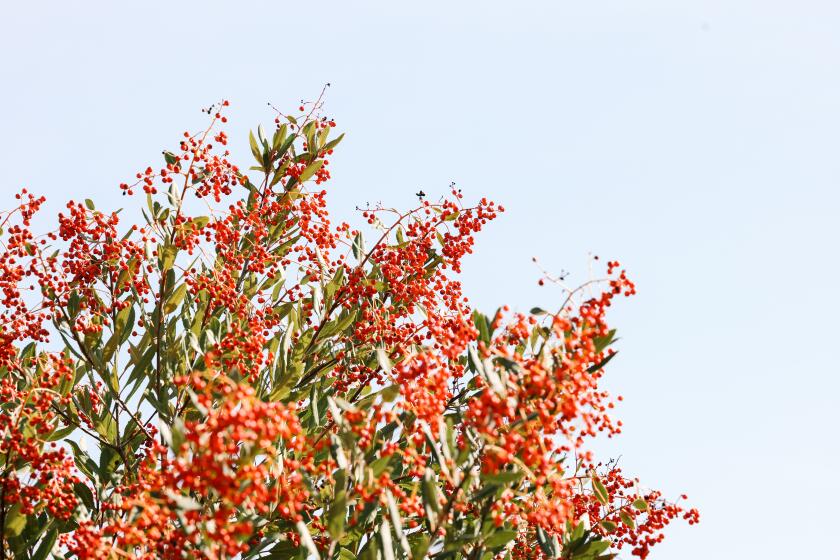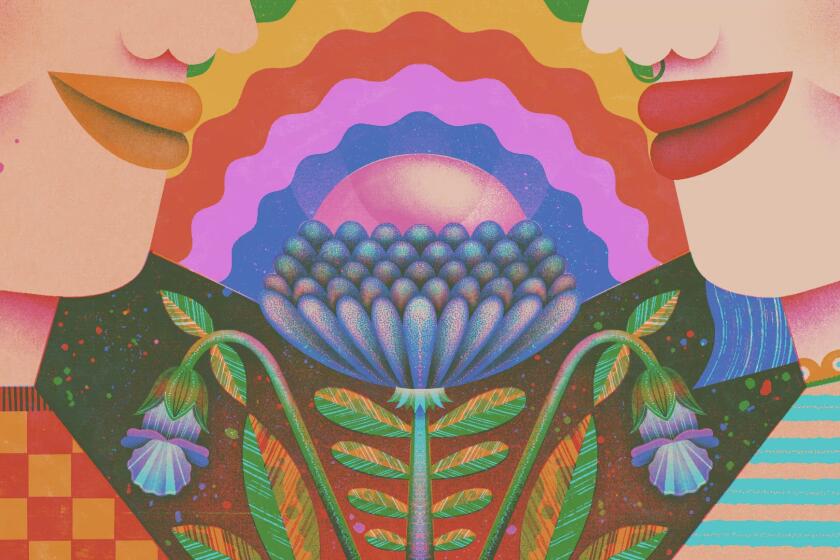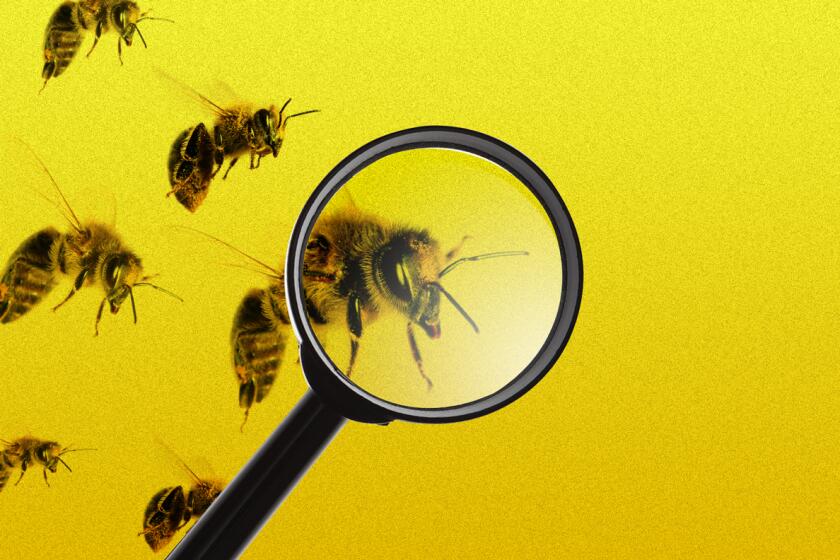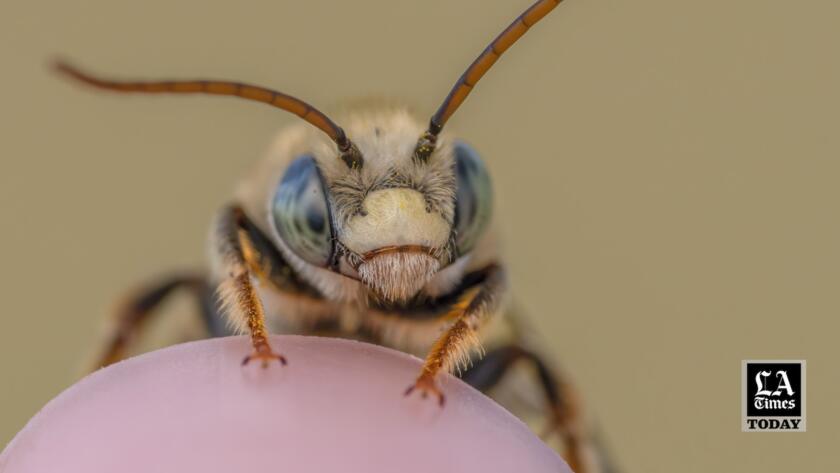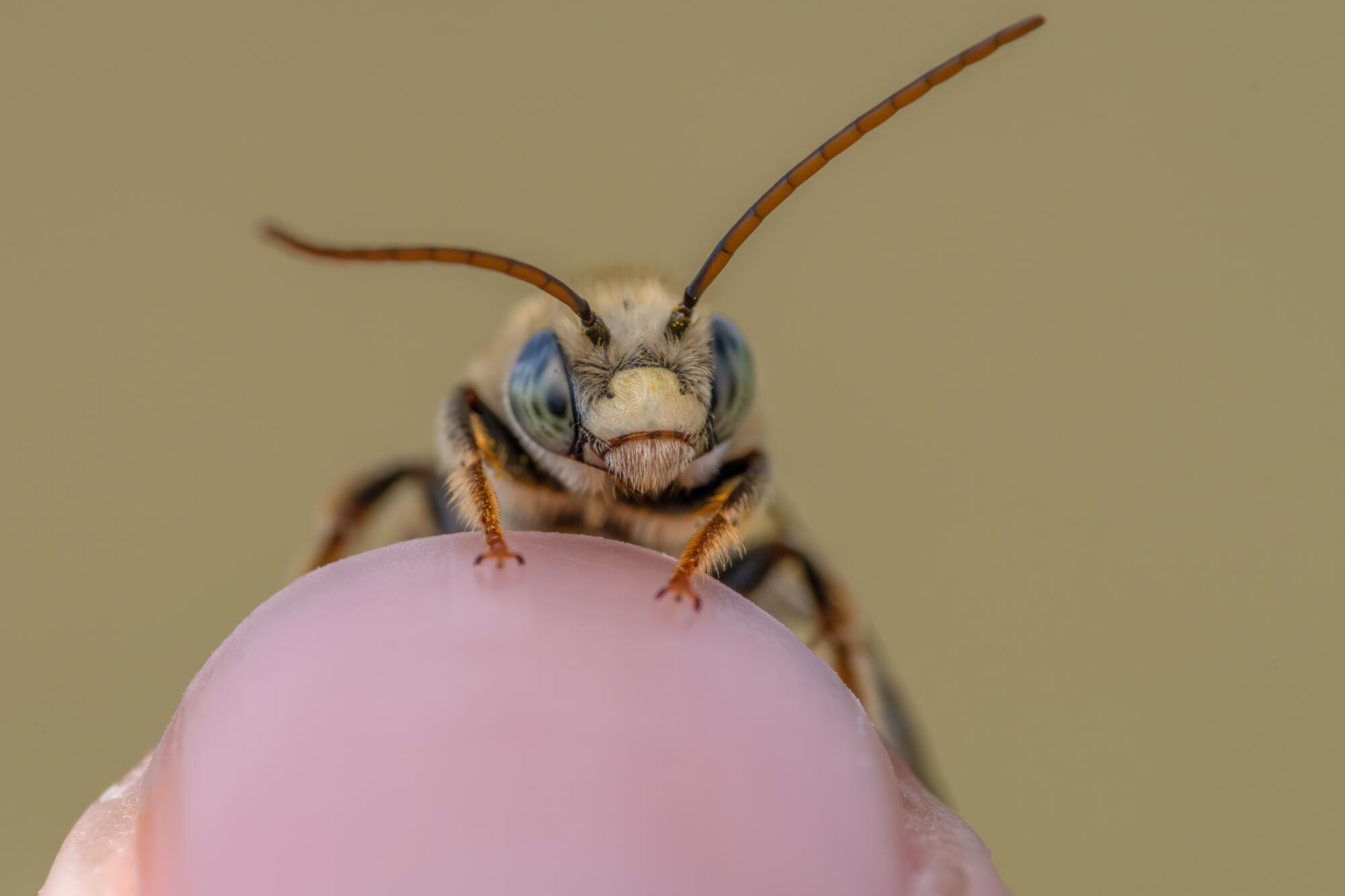
- Share via
Krystle Hickman is the epitome of single-minded. She’s polite and friendly with the reporter and photographer trailing her through the sand and rocks of the Acton Wash Wildlife Sanctuary south of Palmdale, but her distraction is apparent. There’s clearly something else buzzing in the back of her mind.
Bees. But not the European-immigrant honey bees that live in hives and pollinate our crops. There are plenty of those hogging the fading rabbit bush blooms growing in thick gold clusters throughout this wash.
No, Hickman is searching for a special California native bee, Triepeolus verbesinae, a parasitic wasp-shaped “cuckoo” bee, so named because its behavior is similar to cuckoo birds, which lay their eggs in the nests of other birds. Cuckoo bees go one better: The female Triepeolus lay their eggs in the nests of other bees so their young can feast on the pollen left by the host mother, as well as the eggs or larvae in the hosts’ nests.
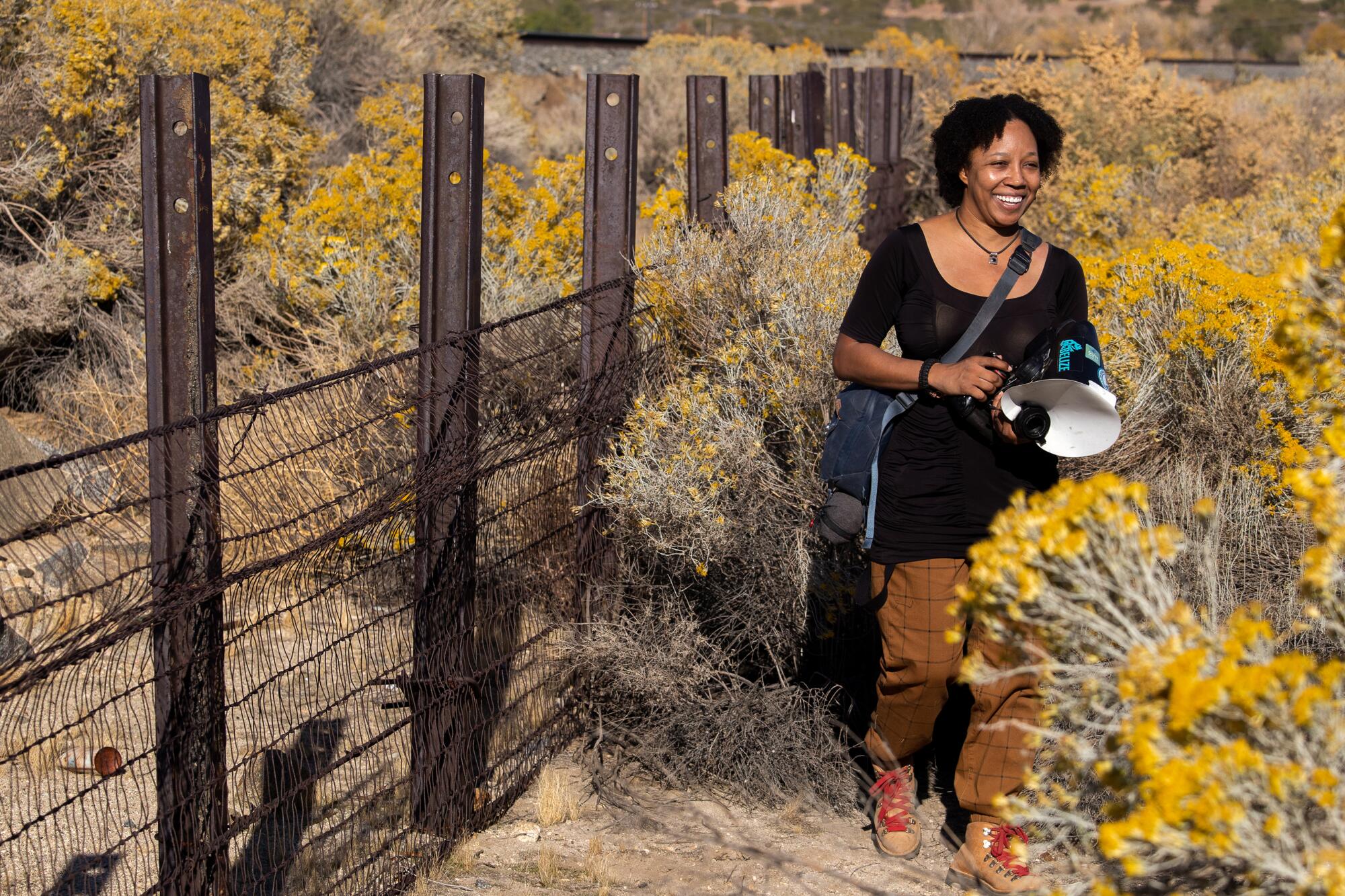
She seems amused and slightly puzzled when I recoil at that description.
Did you know, she said with a kind of wonder, that Triepeolus sleep by clenching their tiny jaws around the stem of a plant, so they won’t fall off? Or that California is a hot spot for native bees? Of the 4,000 or so species in the United States, she said, more than 1,600 reside within the state’s borders.
The Sink Twice toilet sink saves water, saves money and makes hand-washing fun. What better way to help save the environment?
Most people don’t even realize that native bees are different from honey bees, which pollinate most of our crops. Native bees are actually considered more efficient pollinators, she said, and some farmers in California are trying to lure them into their fields by lacing their crops with native plants, their preferred nectar source. Bonus: Native bees rarely sting!
You can follow Hickman’s fascination on her Instagram page @beesip, where she’s posted dozens of photos and a few videos of bees in the wild — nectaring, mating or just resting adorably on her finger.
Hickman said she was like most people when she started, oblivious that native bees even existed. But after three years of study, her fervor to make people aware of them has only increased. That’s why she’s working on creating California native bee flashcards, along with an alphabet picture book of California native bees from A to Z that she intends to self-publish if she can ever get all the images she needs of these often elusive creatures. Right now, she needs photos of Triepeolus verbesinae to fill page “V.”
We’re here in rural Acton, about 40 miles north of Hickman’s North Hollywood apartment, because these bees typically invade the nests of Melissodes, a.k.a. “long-horned” bees, so named because of their long antennae. Unlike honey bees, which live in hives, Melissodes are a solitary species of native bees that build their nests in the ground, and they’ve been spotted recently in the Acton preserve. Where Melissodes are, Hickman reasons, Triepeolus will follow.
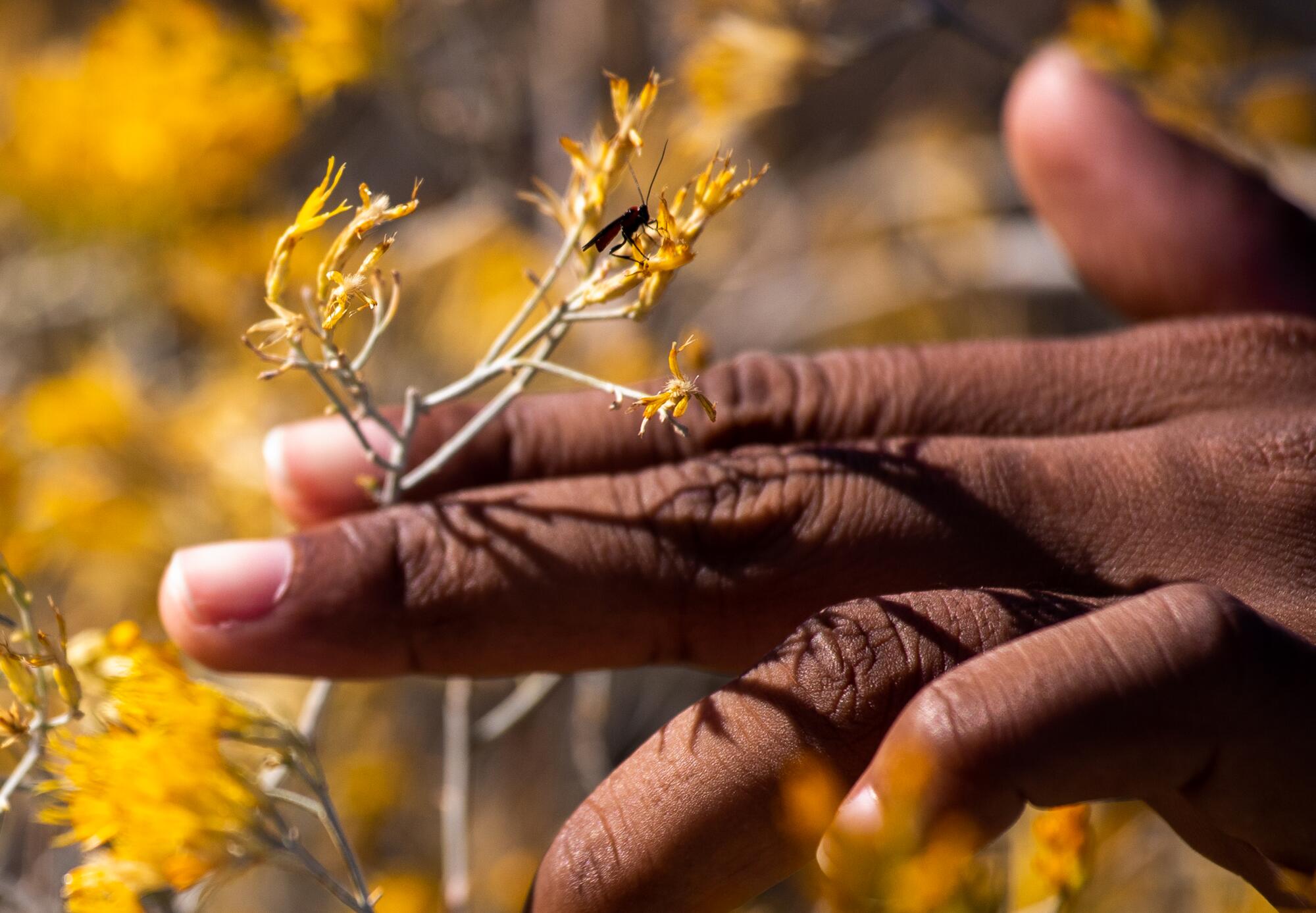
This kind of searching is part of Hickman’s normal routine these days. She spent much of the pandemic wandering alone around California deserts, mountains, native plant gardens and even the Channel Islands looking for native bees. She’s used to standing, crouching or lying by native shrubs for hours, waiting for a special bee, or scouring the ground for burrows where newly hatched bees crawl into the light, and then documenting the conditions when she finds them.
That focus almost got her into trouble in Apple Valley last year, when she spent several early-morning hours staking out some plants in a desert neighborhood in search of Perdita minima, the smallest known bee in North America; it’s “about the size of a letter on a quarter,” she said. The plants were away from houses, but nearby residents called the police on her twice — once telling the officers she was passed-out drunk, “which I was not,” Hickman said emphatically, clearly still miffed. “I don’t really drink at all, but I definitely don’t drink at 9 in the morning.”
December is prime planting time for native plants in Los Angeles, and habitat restoration projects are looking for volunteers ... or is it the other way around?
The officers were nice the first time, she said, and more suspicious the second, “although you’d think the camera and all my gear would kind of give it away.” She was able to get photos of the Perdita minima but not the hard-to-spot burrows she hoped to also find. She would have searched longer, but the second police visit cemented her departure. “I won’t be going back,” she said — though she’s already got plans to look for burrows in Joshua Tree, far from any houses.
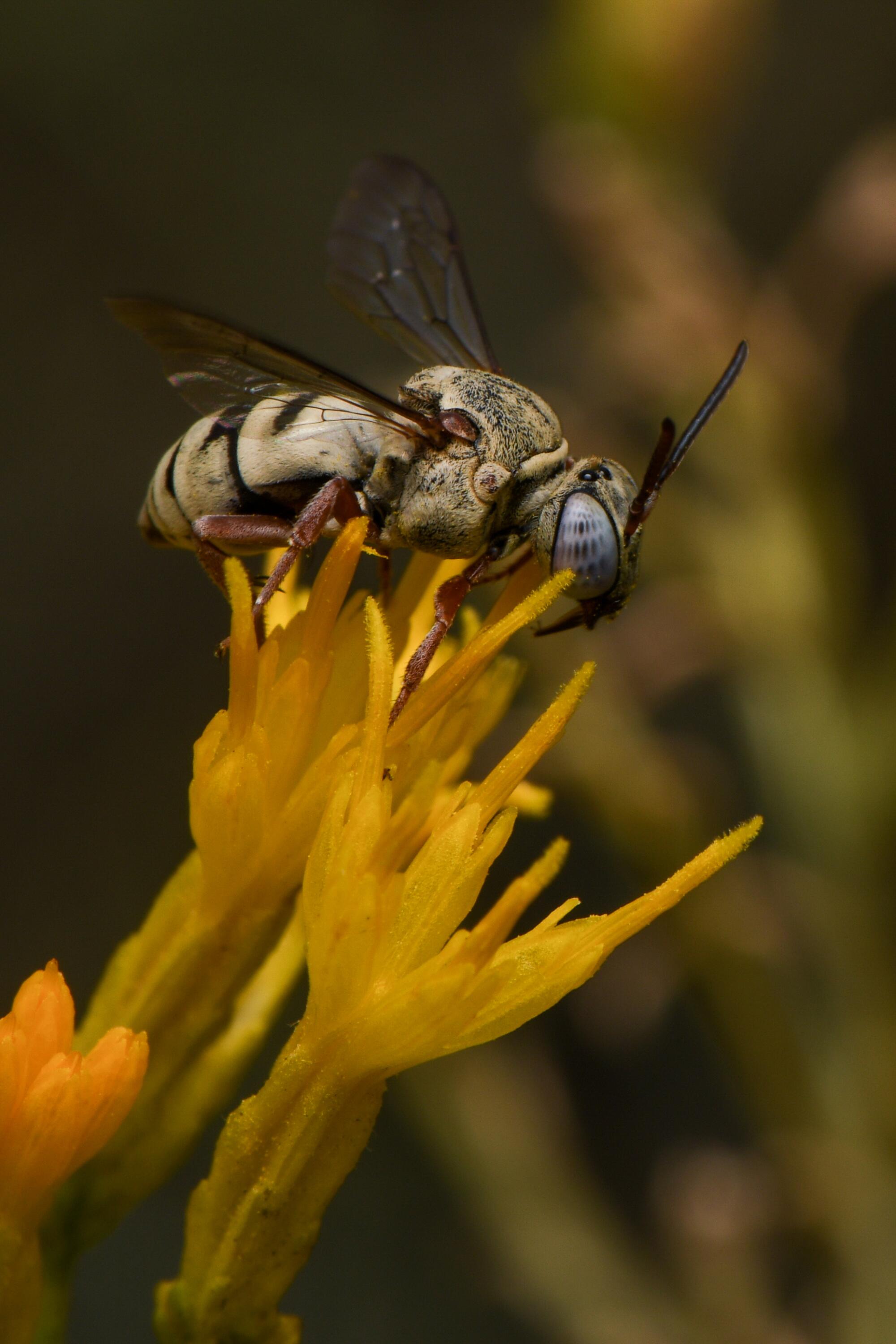
She’s had other, less dramatic encounters too — like people coming up behind her and standing there, without speaking, even after she turned around and said hello. She notes that a fellow photographer, who is white, visited the same area in Apple Valley looking for bees and no one called the police on him. But these kinds of incidents don’t happen often, she said, and they’ve done nothing to dim her ardor.
For instance, she’s on a personal quest to find and photograph California’s four endangered bumble bees — she’s got Bombus crotchii already, and another, Bombus franklini, could well be extinct, since researchers haven’t seen one since August 2006. But she’s still looking, because that’s how Hickman rolls.
With all this activity, you might assume Hickman is a trained entomologist, or insect scientist, working with a juicy research grant or in a university position. Instead, she’s a self-taught artist, photographer and now community scientist motivated by her passion and curiosity, along with the faint hope that someday all this might pay off in photo royalties, book sales or a momentous discovery. Though she’s worked office jobs on and off for the last couple of years to boost her dwindling savings, the 9-to-5 hours kept getting in the way of her bee hunting, so she’s quit those jobs and decided to play the long game — living on income from art and photo sales, classes and talks until she can finish her flashcards and book.
Luckily, she’s also a frugal person, who’s managed to save enough to tide her over when jobs get in the way of her passion and she has to quit. (She learned how to save from her mother, a financial whiz who gave her $100 for her sixth-grade graduation on the condition that she put it all in a new savings account.)
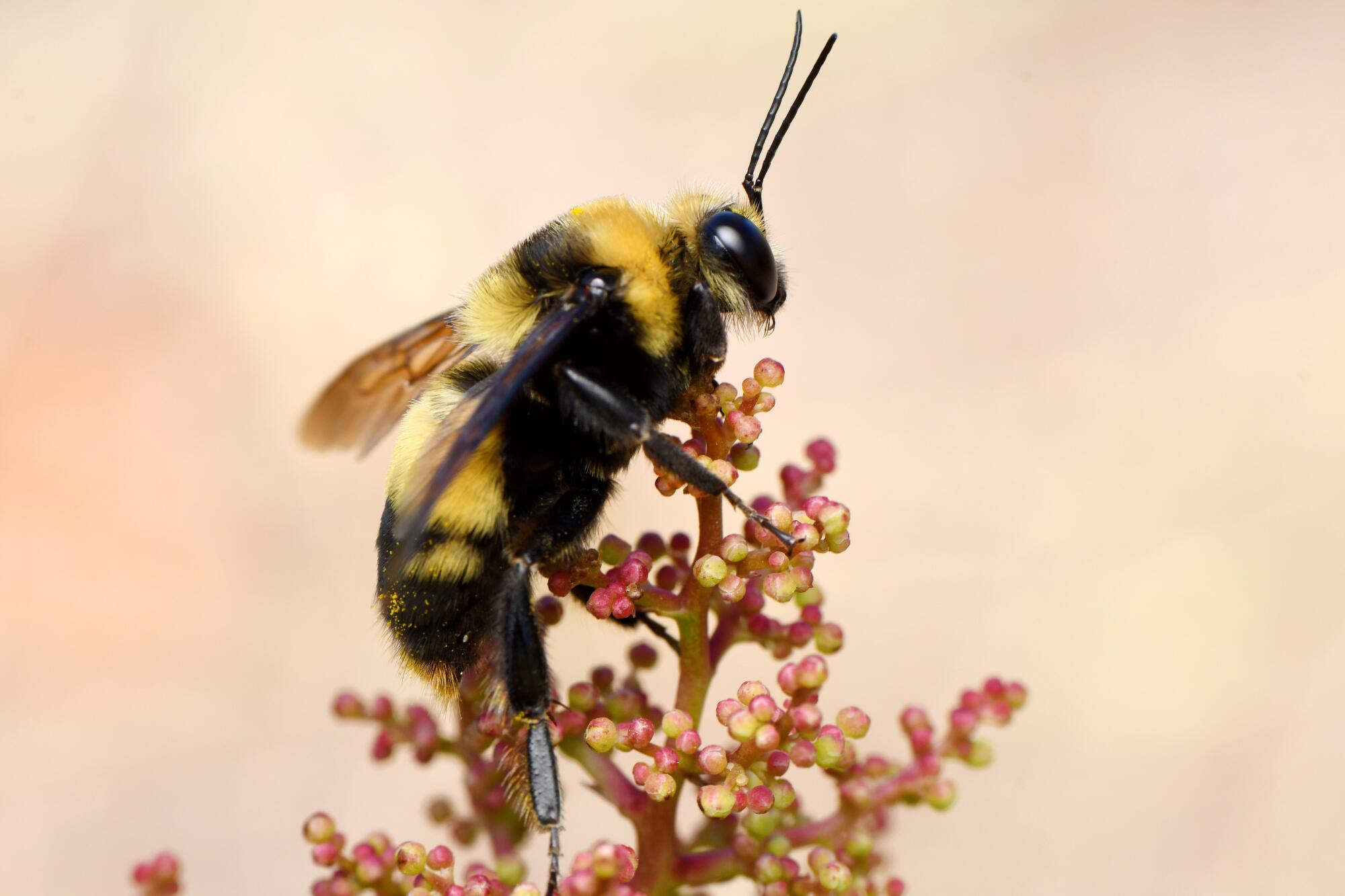

That’s not to say her quest is cheap. Hickman pays out plenty for gas (she can drive hundreds of miles in a month) and for good camera equipment (a Nikon D500 camera with multiple macro lenses and 150x and 250x magnifying diopters to zoom in on bees as small as half a sesame seed).
She can identify most bees at a glance and rattle off countless bee facts and statistics, but Hickman never got a college degree. She spent three miserable years working on a business major at the University of Nebraska in Omaha, her hometown, but dropped out because she hated the classes. She’s thought about returning to school to get a degree in entomology, but that would mean going into debt, something she’s not willing to do right now.
So whenever she’s not working on her art or out taking photos, Hickman is self-educating, scouring native bee websites or spending hours at UC Riverside’s Entomology Research Museum measuring preserved bee specimens and memorizing their characteristics so she can better identify them in the wild.
That dedication and scholarship sets her apart from other amateur photographer/scientists, who usually focus on easy, showier subjects like birds or butterflies, said entomologist Douglas Yanega, collection manager for the museum and a native bee specialist who first identified one of the state’s smallest native bees, Perdita yanegai, as a new species in 2016.
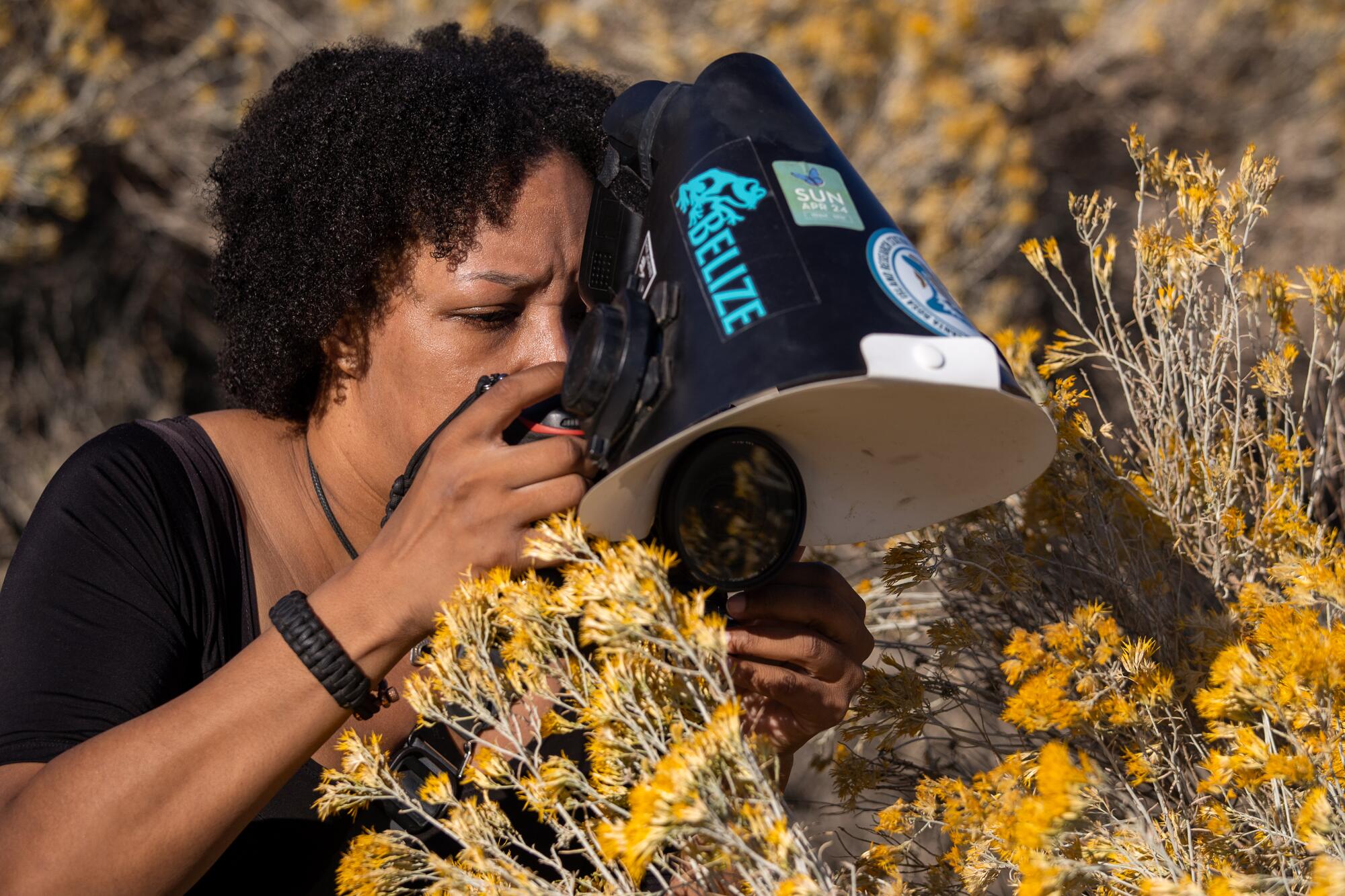
“There are very few people who are not entomologists taking photos of insects, and the list gets narrower with people willing to take photographs of things that are very small,” Yanega said. “But what makes Krystle really different is she has an agenda in mind. She’s generating a very large number of research-grade observations, because she knows what she’s looking for.”
For instance, on a trip to the Kelso Dunes in the Mojave Desert, Hickman managed to track down the rare, sesame-seed-sized Perdita yanegai that Yanega discovered and take the first photos of it alive in the wild. At just 4 millimeters long, Perdita yanegai is one of the state’s tiniest native bees, Yanega said. Hickman had to spend hours around its host plant, the small, low-growing Tiquilia plicata, to get her photos.
“She’s trying to train herself like a scientist, and I’d say she’s becoming a bee authority,” Yanega said. “She’s taken the time to train and develop, and that’s exceptional, because there aren’t a lot of people like that who aren’t professional entomologists.”
California native plants have many pros, but their potent scents are the biggest draw of all. Gardening experts share the most fragrant native plants.
Unfortunately, back in Acton, Hickman’s not having much luck on this brisk sunny afternoon at the end of November. We’ve been wandering the preserve for more than an hour, and all we’ve seen are a few small wasps, a couple of ants, a housefly and lots of honey bees, which is a bad sign.
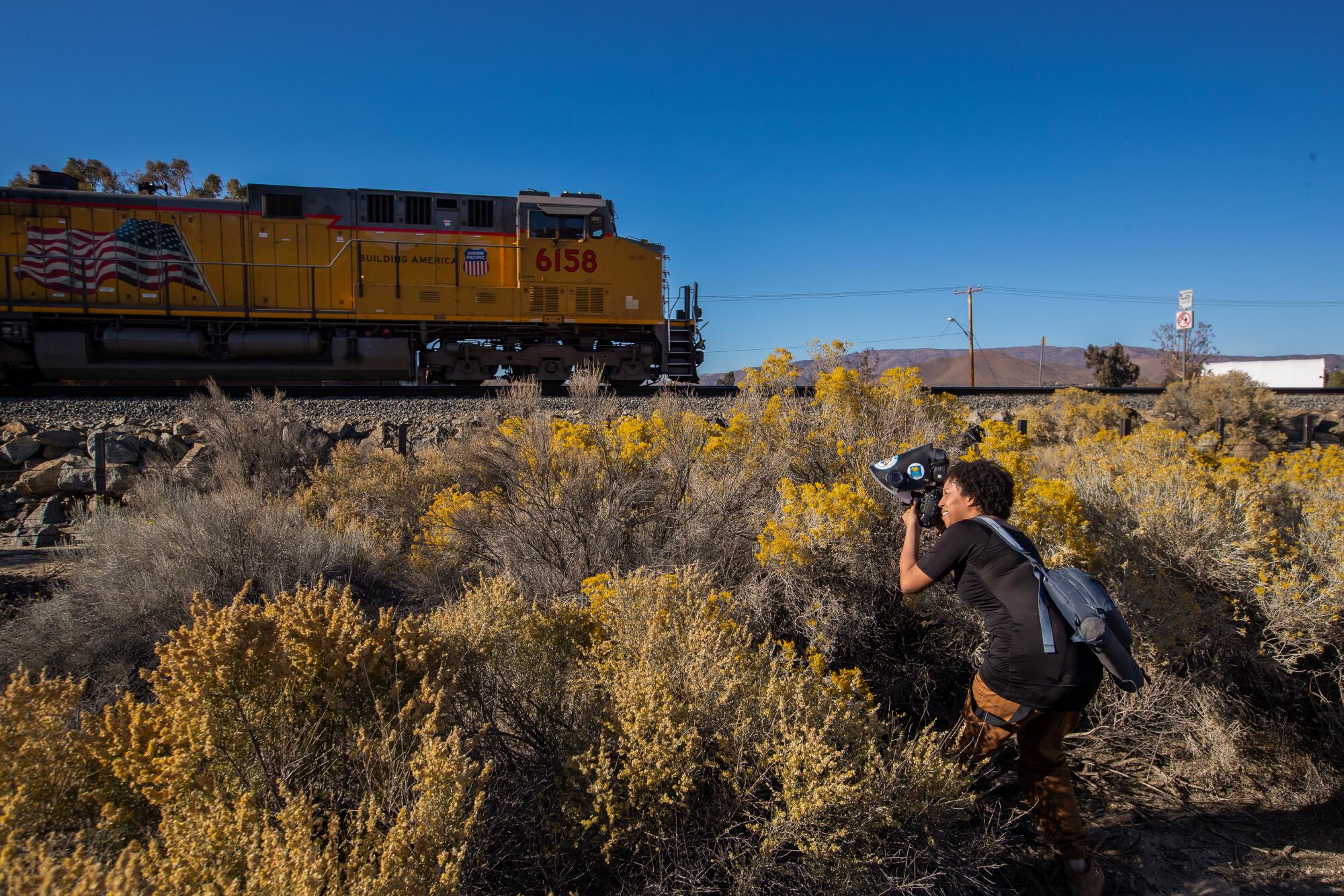
Native bees tend to avoid honey bees, which don’t share flowers well, Hickman said, and have even been caught stealing pollen from the legs and abdomens of native bees.
There’s no attempt at being neutral here. Honey bees are almost robotic, she said, going about their duties with seemingly mindless precision. Native bees seem much warmer, with personalities she’s been able to capture in her photos. Take native bumblebees, which look like little black and gold pandas, furry, a bit bumble-y and very lovable. They sleep in flowers, their little bottoms exposed to the rising sun. They rarely bite or sting, and sometimes when they’re waking up she can coax them onto her finger.
One time, she was staking out some bee burrows in the ground at the Los Angeles County Arboretum’s Crescent Farm, and she watched three newly emerged Melissodes bees crawl out of the hole. One of the bees had a deformed wing so it couldn’t fly, she said. She carried it on her finger for a while and then left it to its fate on a poppy flower, where she hoped it would be protected from predators, at least for a while. “It probably got eaten pretty quickly,” she said, “but maybe it got to enjoy a nice day on the flower.”
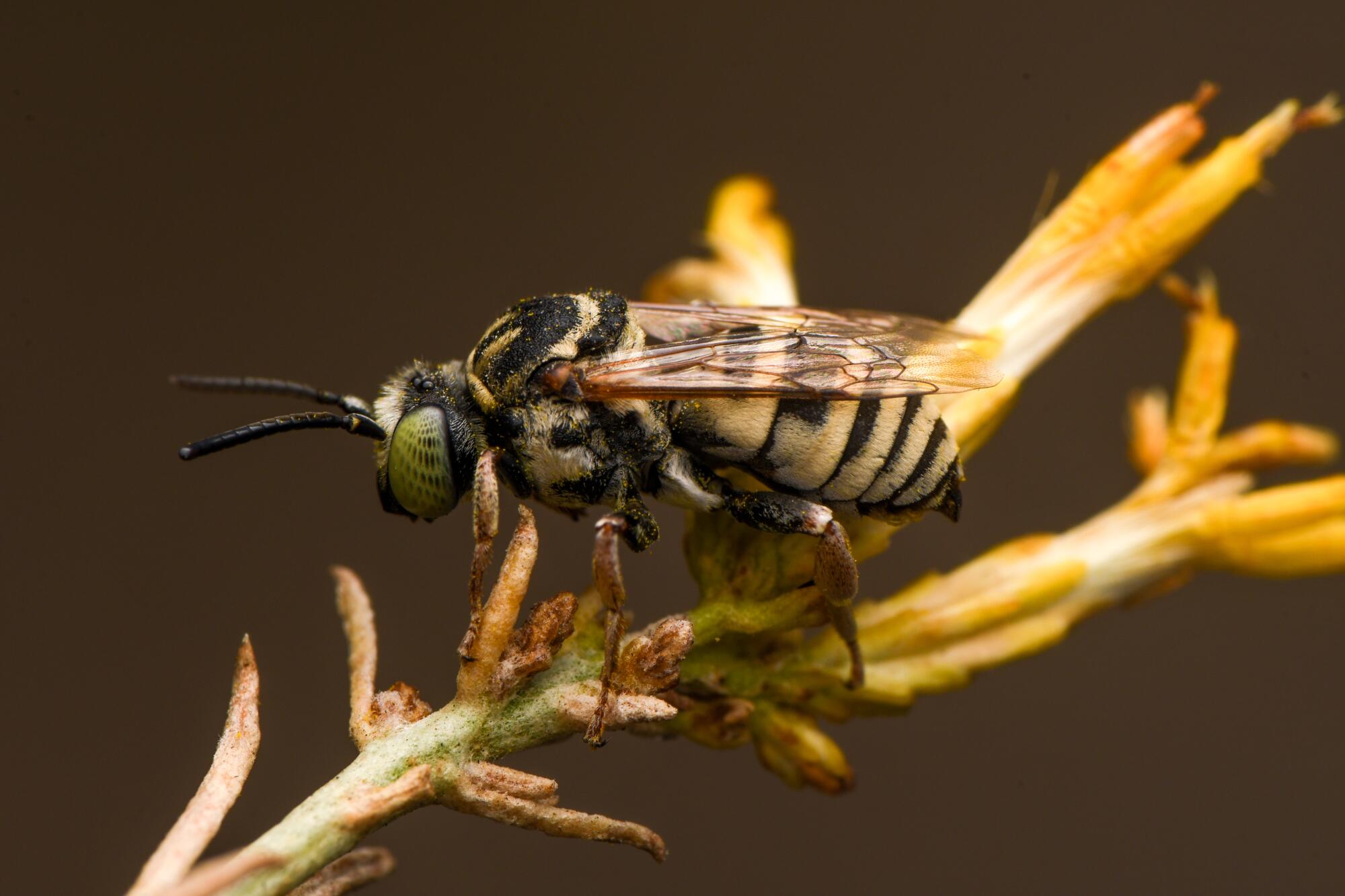
Her lack of enthusiasm for honey bees is a little ironic because without them, Hickman might never have discovered her passion for native bees. “When I get into something, I just dive on in,” she said a little ruefully, “so I spent a ridiculous amount of time photographing honey bees before I learned they were invasive farm animals and not endangered at all.”
Hickman’s curiosity and creativity have always brought her closer to her passion, but trying to track her path is like peeling an onion — there are an incredible number of layers for someone who’s just 37, so it takes a while to get to the beginning, when she was growing up in Omaha.
Her mom, a single parent, was a computer programmer who managed her money so well she retired early. She didn’t just teach Hickman how to save, her mother got a credit card jointly in her name and her daughter’s when Hickman was just 8. Her mother used the card sparingly and paid it off every month, Hickman said, and when she turned 18, her mother presented her the gift of “excellent credit.” Hickman wasn’t excited about the “gift” then, she said, but she realizes its importance now, if only because it made it easier for her to find an apartment.
Growing up, Hickman found insects interesting, and her fellow Girl Scouts described her as fearless about picking them up. But her goal was always to become a veterinarian. She got scholarships to several schools to study veterinary medicine, but at the 11th hour her mother suggested she work in a clinic to test the waters. That’s when Hickman discovered she didn’t like veterinary work at all. So she turned down the scholarships and enrolled at the University of Nebraska. She chose a business major because she had to choose something, and that’s how she ended up studying a subject she despised until she quit.
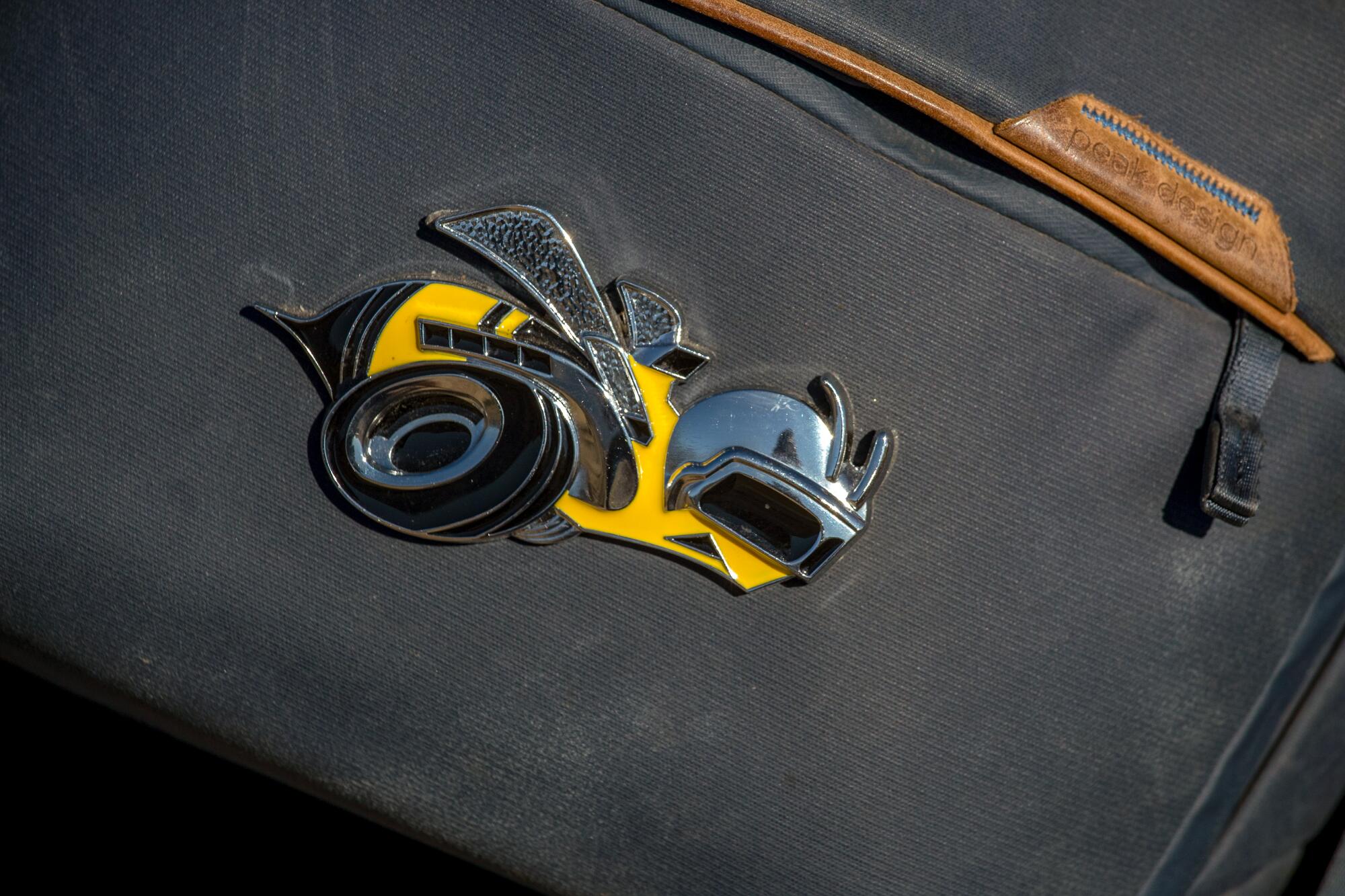
Then, like countless others, she decided to move to Los Angeles to become an actor, with no contacts or real knowledge of the industry. It was 2006 and she was 21. She got a job as an administrative assistant for a financial firm in Westwood “because it seemed like the responsible thing to do,” but after two years she quit that as well, as she said in her 2021 TEDxUCLA talk, “because I desperately wanted to find something to be passionate about.”
She refocused on acting, her original goal, working at a gym in the early hours so she’d be free for auditions during the day. Though she got a few small parts, she was so discouraged by the stereotypical roles she was offered that she started to create her own work, writing, directing and starring in a short film called “Stay” that was released in 2016.
She also began developing as an artist. While she was working as an administrative assistant, she started drawing at her desk, using the only medium available to her — a ballpoint pen. She hadn’t done any sketching since she was in middle school, but soon, she began using pens and, later, table sugar on black paper to make stunningly detailed portraits of animals and people. She usually worked from photos, and got work drawing celebrities or artwork for television shows.
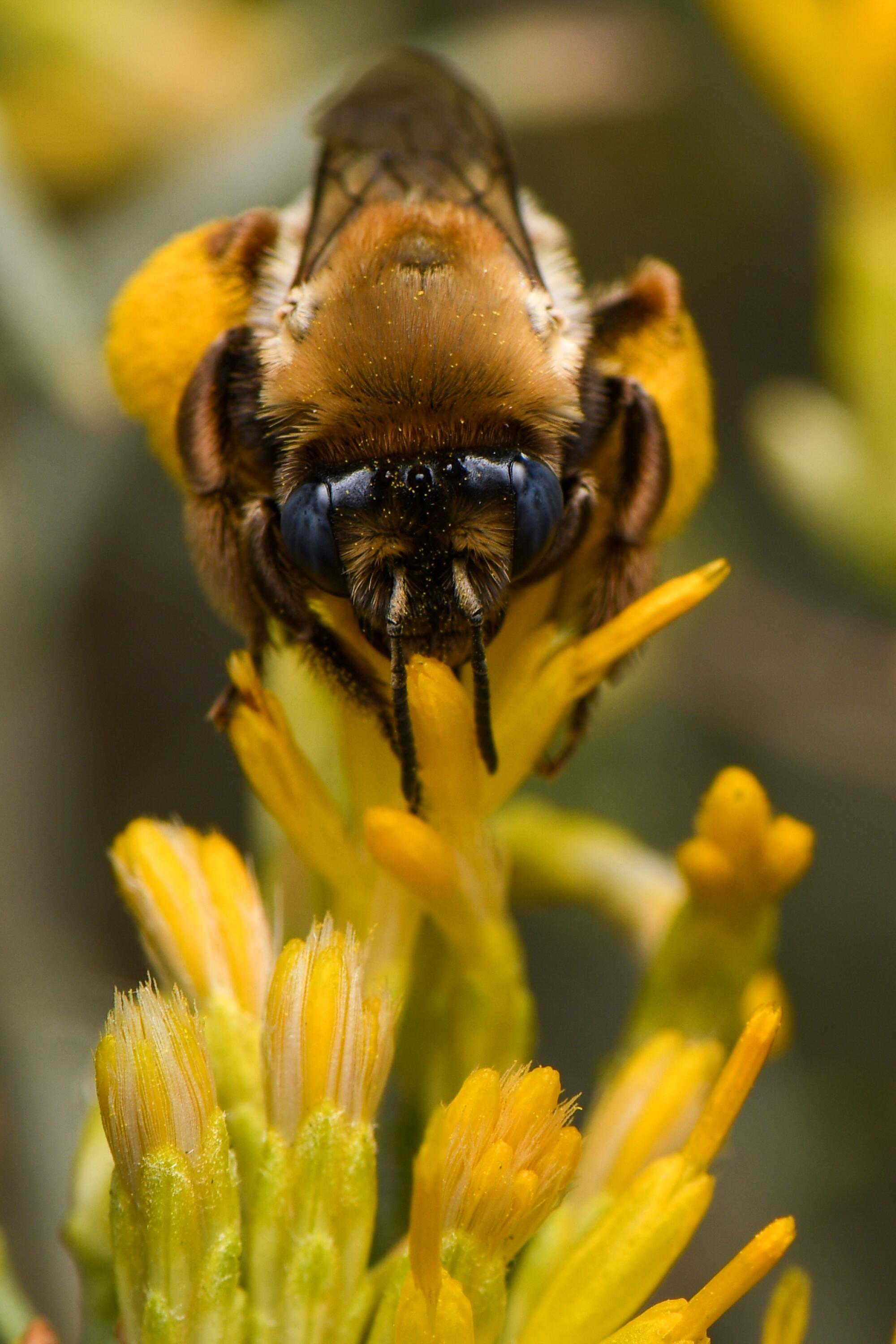
To avoid copyright issues, she decided to start photographing creatures and scenes she wanted to re-create in her art. She’d never taken photos before, aside from snapshots as a child, but once again she didn’t let a lack of knowledge slow her down. She heard honey bees were in trouble, so she turned her laser focus on taking photos of them until one day she spotted a bee she’d never seen before.
Other people might have looked at the strange bee and shrugged, but Hickman had to know. When she started investigating, Hickman discovered it wasn’t a honey bee at all but a native bee known as Andrena. She also learned that there are thousands of native bee species — at least 20,000 worldwide — and it’s native bees, not honey bees, that are threatened and endangered, because of things like habitat destruction and pesticide and herbicide use.
Two new studies show ways L.A. gardeners can help bees by avoiding this too-common insecticide and planting what’s beneficial.
Honey bees were pretty much dead to her after that, at least when it came to taking photos.
She spent weeks searching unsuccessfully for more native bees, until she saw a social media posting from the Crescent Farm, featuring photos of four native bees spotted that day on its native plants. “I didn’t realize the connection between native bees and native plants,” Hickman said. “All I’d seen were honey bees in people’s yards, which is kind of a desert for native species.”
Her whole world shifted then in August 2019. She began driving hundreds of miles to look for native bees in natural areas with native plants. The pandemic was actually helpful, she said, because it’s easy to isolate in the remote areas where she could wander alone, searching for bees.
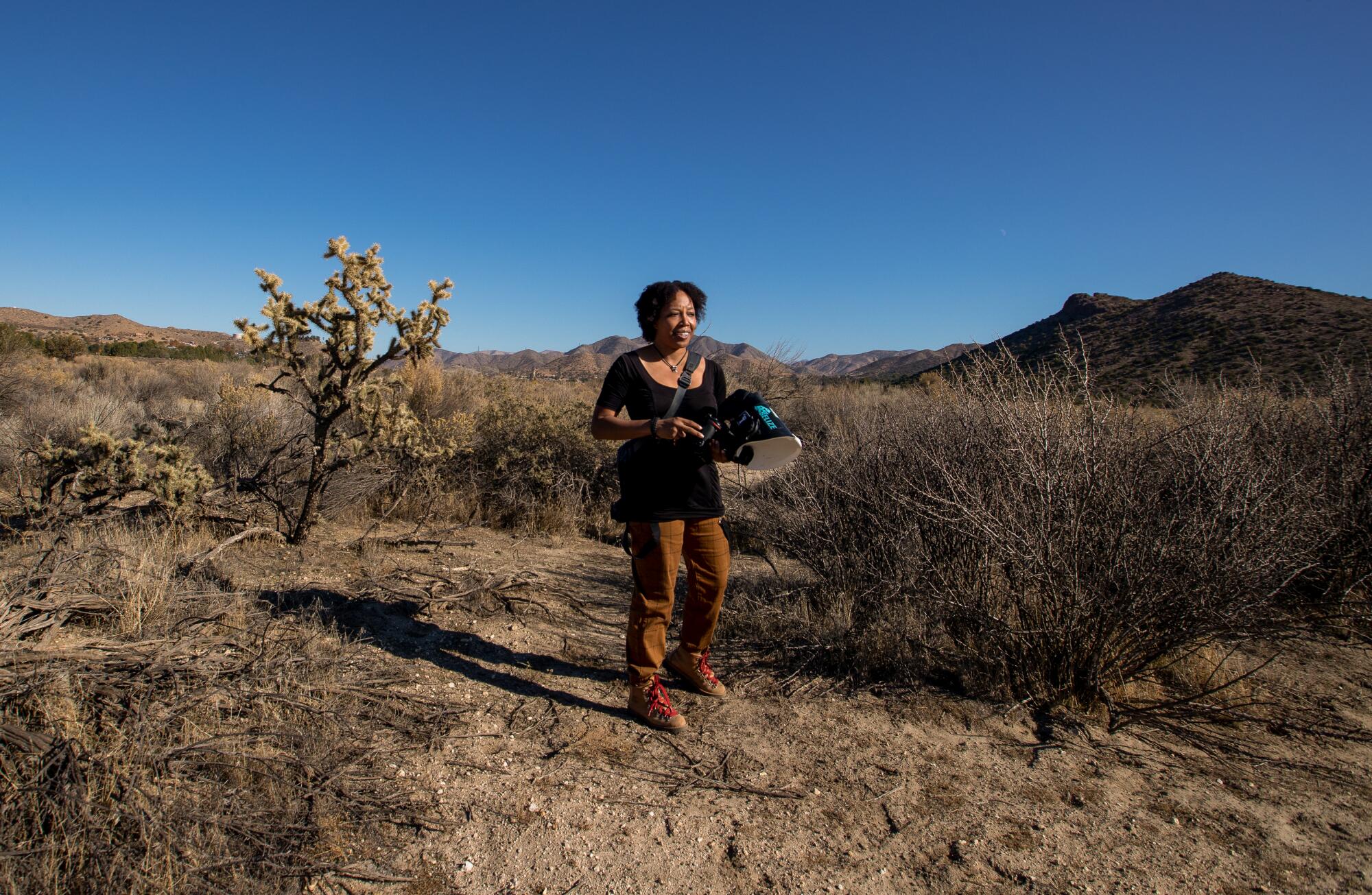
Hickman’s work has become well-known and respected. At the California Native Plant Society’s conference last October, hers was one of the most popular presentations. She has some online classes coming up at the Theodore Payne Foundation on Jan. 14 and 28, and once native plants start blooming again, she hopes to offer classes in the field.
She’s become a native bee evangelist, spreading the word about their importance to our environment and how badly they need native plants to thrive.
Hickman knows she’s taken lots of turns before. But her “A, Bee, Cs of Native Bees” book and her flashcards are projects she’s eager to complete. She’s also driven by the thrill of the chase and coming face to face with another sweet little bee willing to trust her enough to crawl onto her hand.
Who knows the future, she said, “but this is something I’ve loved for quite a few years, and I really love right now, so I’m committing to it.”
At long last, she’s gotten the bug all of us crave — something to be truly passionate about.
- Share via
Watch L.A. Times Today at 7 p.m. on Spectrum News 1 on Channel 1 or live stream on the Spectrum News App. Palos Verdes Peninsula and Orange County viewers can watch on Cox Systems on channel 99.
More to Read
Sign up for The Wild
We’ll help you find the best places to hike, bike and run, as well as the perfect silent spots for meditation and yoga.
You may occasionally receive promotional content from the Los Angeles Times.

